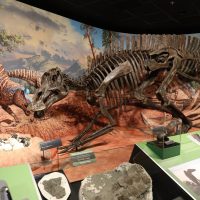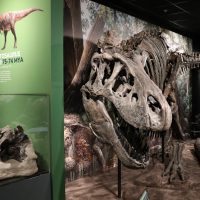Open Daily
Cretaceous Crossroads
On Earth, it is generally true that where there is water, there is life. This was certainly the case with the Western Interior Sea during the Late Cretaceous. This large seaway, which bisected North America, was not only teeming with marine life; it also cultivated a rich habitat for plants and animals along its shores. As mosasaurs and other aquatic reptiles hunted beneath the waves, tyrannosaurs ascended to the top of the food chain on land, where they remained until the end of the Cretaceous, when the age of the dinosaurs drew to a close.
For the first time in over ten years, Museum of the Rockies unveiled a new primary paleontology exhibition in 2025. Cretaceous Crossroads explores the time of transition, with a focus on three geologic formations in Montana (Two Medicine, Judith River, and Bearpaw) that span the period from 72 to 82 million years ago. The exhibit is comprised of real fossil material, 3D prints, casting, reproductions, murals, new paleo-art, AV interactives, an augmented reality piece, microscope stations, discovery drawers, and more.
Visitors will see a mounted Maiasaura (Montana’s State Fossil) tending to its nest, a 30-foot-long Daspletosaurus horneri (large meat-eating dinosaur, cousin to T. rex, dinosaur eggs and clutches, Troodon (small raptor-like dinosaurs), a 23-foot-long Mosasaurus, and many other specimens, some of which are only known from Montana. This includes never-before-seen specimens that are not just new to Museum of the Rockies; they are new to science!





